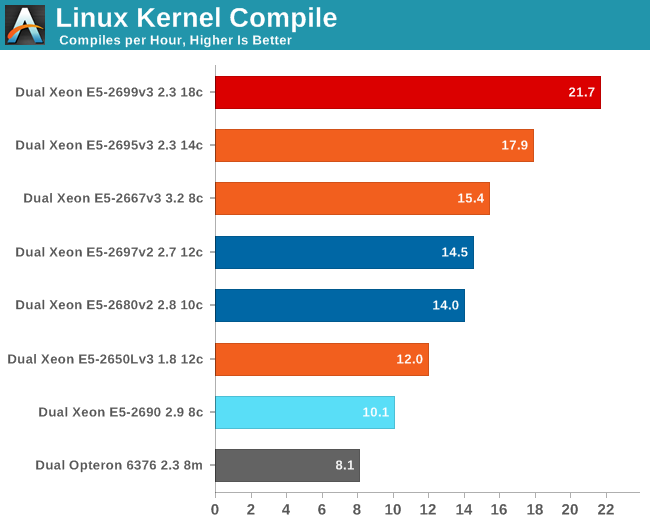Intel Xeon E5 Version 3: Up to 18 Haswell EP Cores
by Johan De Gelas on September 8, 2014 12:30 PM ESTLinux Kernel Compile
A more real world benchmark to test the integer processing power of our Xeon servers is a Linux kernel compile. Although few people compile their own kernel, compiling other software on servers is a common task and this will give us a good idea of how the CPUs handle a complex build.
To do this we have downloaded the 3.11 kernel from kernel.org. We then compiled the kernel with the "time make -jx" command, where x is the maximum number of threads that the platform is capable of using. To make the graph more readeable, the number of seconds in wall time was converted into the number of builds per hour.

A kernel compile does not scale perfectly with more cores, but the Xeon E5-2699 still holds a healty lead over its 14-core brother. The Haswell architecture's improved integer core plays a larger role here than in compression as the E5-2697 v2 with 50% cores and a maximum clock of 3GHz (all cores Turbo Boost) cannot overtake the 3.2GHz Xeon E5-2667 v3. It is worth noting that the latter cannot Turbo Boost with all cores active.
The advantage over the Sandy Bridge EP is significant: 50% higher performance while the clock speed is only slightly higher as the Xeon E5-2690 can run briefly at 3.3GHz. The new Haswell core is good news for those who regularly deal with large software builds.










85 Comments
View All Comments
MorinMoss - Friday, August 9, 2019 - link
Hello from 2019.AMD has a LOT of ground to make up but it's a new world and a new race
https://www.anandtech.com/show/14605/the-and-ryzen...
Kevin G - Monday, September 8, 2014 - link
As an owner of a dual Opteron 6376 system, I shudder at how far behind that platform is. Then I look down and see that I have both of my kidneys as I didn't need to sell one for a pair of Xeons so I don't feel so bad. For the price of one E5-2660v3 I was able to pick up two Opteron 6376's.wallysb01 - Monday, September 8, 2014 - link
But the rest of the system cost is about the same. So you get 1/2 the performance for a 10% discount. YEPPY!Kevin G - Monday, September 8, 2014 - link
Nope. Build price after all the upgrades over the course of two years is some where around $3600 USD. The two Opterons accounted for a bit more than a third of that price. Not bad for 32 cores and 128 GB of memory. Even with Haswell-E being twice as fast, I'd have to spend nearly twice as much (CPU's cost twice as much as does DDR4 compared to when I bought my DDR3 memory). To put it into prespective, a single Xeon E5 2999v3 might be faster than my build but I was able to build an entire system for less than the price Intel's flagship server CPU.I will say something odd - component prices have increased since I purchased parts. RAM prices have gone up by 50% and the motherboard I use has seemingly increased in price by $100 due to scarcity. Enthusiast video card prices have also gotten crazy over the past couple of years so a high end video card is $100 more for top of the line in the consumer space.
wallysb01 - Tuesday, September 9, 2014 - link
Going to the E5 2699 isn’t needed. A pair of 2660 v3s is probably going to be nearly 2x as fast the 6376, especially for floating point where your 32 cores are more like 16 cores or for jobs that can’t use very many threads. True a pair of 2660s will be twice as expensive. On a total system it would add about $1.5K. We’ll have to wait for the workstation slanted view, but for an extra $1.5K, you’d probably have a workstation that’s much better at most tasks.Kevin G - Friday, September 12, 2014 - link
Actually if you're aiming to double the performance of a dual Opteron 6376, two E5-2695v3's look to be a good pick for that target according to this review. A pair of those will set you pack $4848 which is more than what my complete system build cost.Processors are only one component. So while a dual Xeon E5-2695v3 system would be twice as fast, total system cost is also approaching double due to memory and motherboard pricing differences.
Kahenraz - Monday, September 8, 2014 - link
I'm running a 6376 server as well and, although I too yearn for improved single-threaded performance, I could actually afford to own this one. As delicious as these Intel processors are, they are not priced for us mere mortals.From a price/performance standpoint, I would still build another Opteron server unless I knew that single-threaded performance was critical.
JDG1980 - Tuesday, September 9, 2014 - link
The E5-2630 v3 is cheaper than the Opteron 6376 and I would be very surprised if it didn't offer better performance.Kahenraz - Tuesday, September 9, 2014 - link
6376s can be had very cheaply on the second-hand market, especially bundled with a motherboard. Additionally, the E5-2630 v3 requires both a premium on the board and DDR4 memory.I'd wager you could still build an Opteron 6376 system for half or less.
Kevin G - Tuesday, September 9, 2014 - link
It'd only be fair to go with the second hand market for the E5-2630v3's but being new means they don't exist. :)Still going by new prices, an Opteron 6376 will be cheaper but roughly 33% from what I can tell. You're correct that the new Xeon's have a premium pricing on motherboards and DDR4 memory.